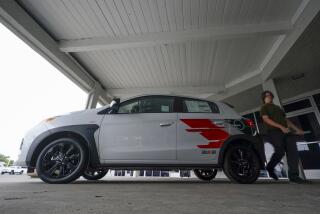Mazda reveals newest MX-5 Miata, 25 years after original model
Twenty-five years after resurrecting the roadster, Mazda has unveiled the latest version of its MX-5 Miata, the bestselling two-seat convertible in history.
The original Miata, a 1990 model, spawned copies from Honda, Toyota, BMW and others. This new crop replaced the charming but notoriously unreliable British roadsters from the likes of MG and Triumph, which by then had halted production.
The Miata also established the Mazda brand as the fun-to-drive alternative to its staid Japanese competitors.
âThe MX-5 Miata stands as the flag-bearer for everything that a Mazda vehicle is,â Jim OâSullivan, president and chief executive of Mazda North America, said ahead of the simultaneous debuts in Monterey, Calif., Tokyo and Barcelona, Spain, on Wednesday night. âTonightâs reveal is a big deal for us.â
The all-new fourth-generation Miata â known only as the MX-5 abroad â goes on sale next year as a 2016 model and is expected to make its North American debut at the 2014 Los Angeles Auto Show in November.
Mazda didnât disclose details on engines, horsepower or other specifications, but expect the formula to stay the same: four cylinders, rear-wheel drive and a six-speed stick shift (an automatic optional). Like all other Miatas, it will prioritize eager handling over raw power.
Mazda shaved roughly 220 pounds off the outgoing model â an impressive feat given the existing car weighs only about 2,500 pounds. It also lost 3 inches in overall length and half an inch in width, a profile closer to the original model. Pricing will likely stay near the current generationâs $24,765 base price.
The design of the new Miata expands on the aesthetic of the rest of Mazdaâs lineup. Narrow, squinting headlights are etched into a sloping front grill. At the back, circular taillights are offset by turn signals that curve around the side of the car.
The overall look is more angular and less cute than the third-generation Miata, but relies less on a retro theme than the original car.
That original Miata defined affordable thrills for a new generation of buyers. Drawing on the heritage of lost roadsters from brands such as Lotus, MG and Triumph, the first-generation Miata proved a sensation at its Chicago Auto Show debut in 1989.
At the time, no one else offered a rear-wheel-drive sports car in a reliable and value-oriented package. Sports cars such as the Nissan Z and Toyota Supra were getting bigger, heavier and more expensive.
Building a small sports car was a risky venture for any automaker in the late 1980s. âMaking a relatively low-volume car on its own dedicated platform didnât make a whole lot of sense,â said Ed Kim, vice president of industry analysis at AutoPacific.
Mazda gambled that the Miataâs sporting ethos would trickle down to the rest of its lineup. The bet worked, and Mazdas have been known as some of the best-handling vehicles in their respective segments ever since.
The original Miata started at just $13,800. With 116 horsepower moving just 2,181 pounds of mass, it offered thrills in the form of an intimate connection with the road.
âIt was all about the handling, having fun at relatively sane speeds at a time when conventional wisdom was that power equaled fun,â Kim said.
In 1990, it accounted for more than 10% of all of Mazdaâs sales â nearly 36,000 cars, according to the automaker. Other affordable sports cars later joined the fray, including the Honda S2000, the BMW Z3, Toyota MR2, Pontiac Solstice and Saturn Sky.
But none could quite match the Miataâs delicate balance of affordable fun.
Over the subsequent generations, Mazda has sold more than 930,000 copies of the Miata globally, enough to earn certification from the Guinness Book of World Records as the worldâs bestselling roadster.
First-generation Miatas could have a future as a collectorâs item. With so many of the cars being driven daily, low-mileage examples in rare colors will probably become a hot item.
âThey absolutely will have collector appeal to them at some point,â said Jonathan Klinger of Hagertyâs Insurance, which insures and tracks classic car values. âIn five years maybe, 10 years definitely,â he said.
Values for the original Miatas have already bottomed out and have begun to climb, the first sign of a burgeoning collectorâs car, Hagertyâs data show. But sales of new Miatas have fallen steadily over the years, with the latest model selling just 5,780 copies in 2013, according to Edmunds.com. Thatâs due to the aging current model and competition from other entry-level sports cars, such as the Ford Mustang and Chevy Camaro.
This low-volume segment remains a risky venture for automakers, a key reason Subaru and Toyota produced their new BRZ and FR-S sports cars â also Miata competitors â in a joint venture. But for a small, independent brand like Mazda, itâs even more tricky.
Thatâs why this new fourth-generation Miata will eventually have a twin. Fiat is working with Mazda to develop its own version of the car, to debut later. This helps Mazda share some of the costs, but it also carries some risk.
âDoing this car with a partner can help the business case dramatically, but it also creates a close competitor,â Kim said. âClearly, Mazda did some math and decided that sharing this car with Fiat was better than doing it alone.â
Twitter: @latimes_driven






